Amplitude modulation and empty lots
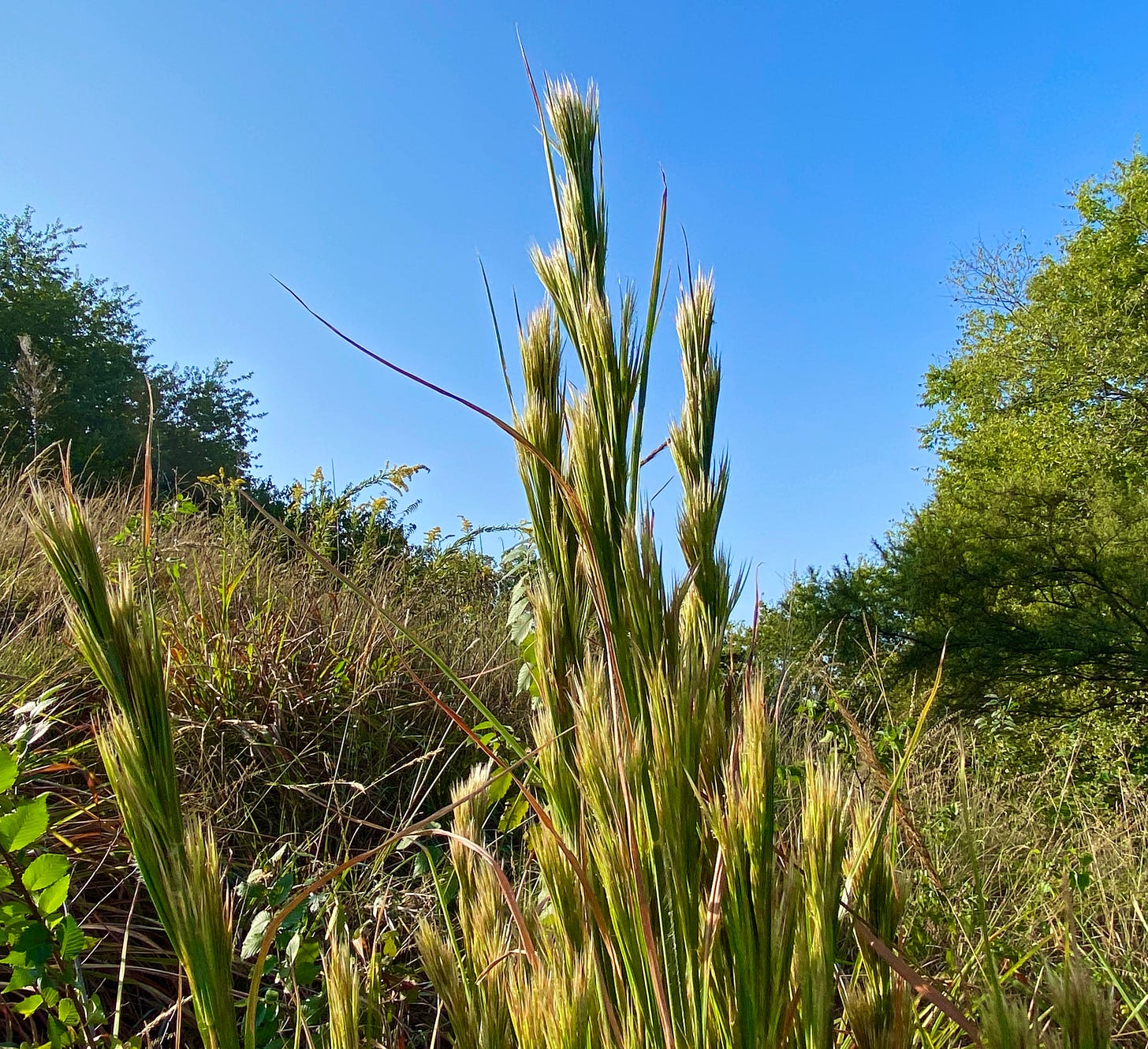
It’s been an exceptionally gorgeous week here, beautiful enough to make you forget the news feed when you step outside. Cool nights and sunny days and butterflies everywhere you turn. The last few flowering plants of the season are popping even as some of the trees begin to lose their leaves and most of the native grasses have dropped their seed. The bushy bluestem, perhaps my favorite of the prairie grasses that grow on our roof, suddenly appeared on Saturday after I had given up on it, helping me learn to associate it with the golden blossoms of October’s tall goldenrod. The snout migration is in full force, and I got a clue as to why those long-nosed flitterers persist in such numbers while the other butterflies dwindle, when I saw one on Sunday afternoon licking tree sap off the windshield of my truck, crazy spiral tongue unfurled against old window glass. Survival of the fittest, indeed.
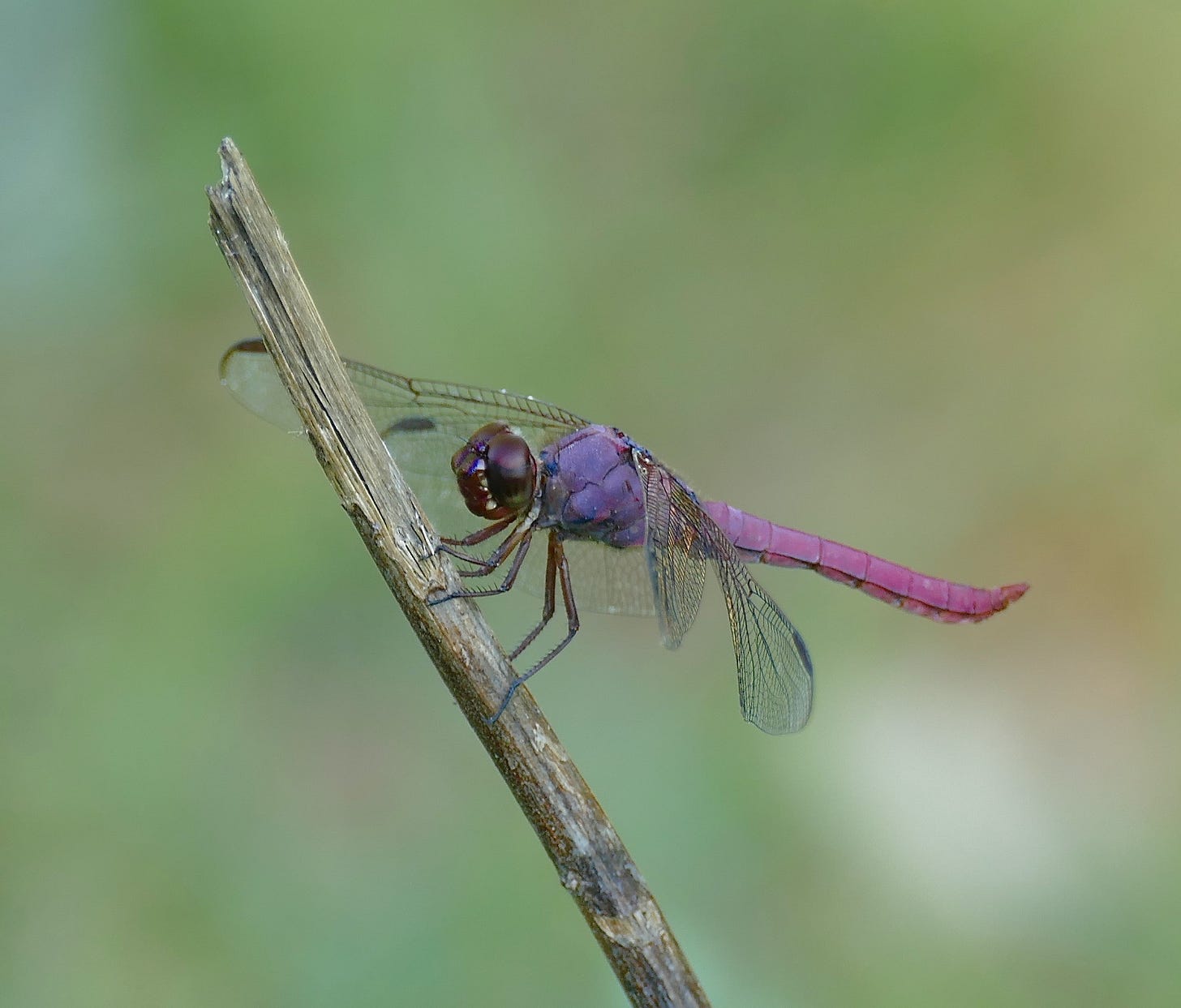
I thought that would be the most remarkable insect encounter of the week, until I came upon this beautiful Roseate Skimmer Wednesday afternoon. I had seen one last week as well—just a glimpse of those insane pink and purple colors—but this time it hung around long enough for me to go get my real camera.
The purple is the male of the species, reputed to be highly territorial. The females are burnt orange. They breed in mud, which helps them adapt well to our disturbance of the land. Ditches and open tanks can be adequate habitat for them, conditions that are common with the livestock production and road construction near here. It’s remarkable that a creature of such seemingly delicate alien beauty can thrive amid the ugliness we create. Those ocelli, the little eyes that nestle in the big compound orbs like garnets floating in red wine, staring back at you from a dried-out sunflower stalk that reminds you that even the dead plants have a place in the microecology of a wild yard.
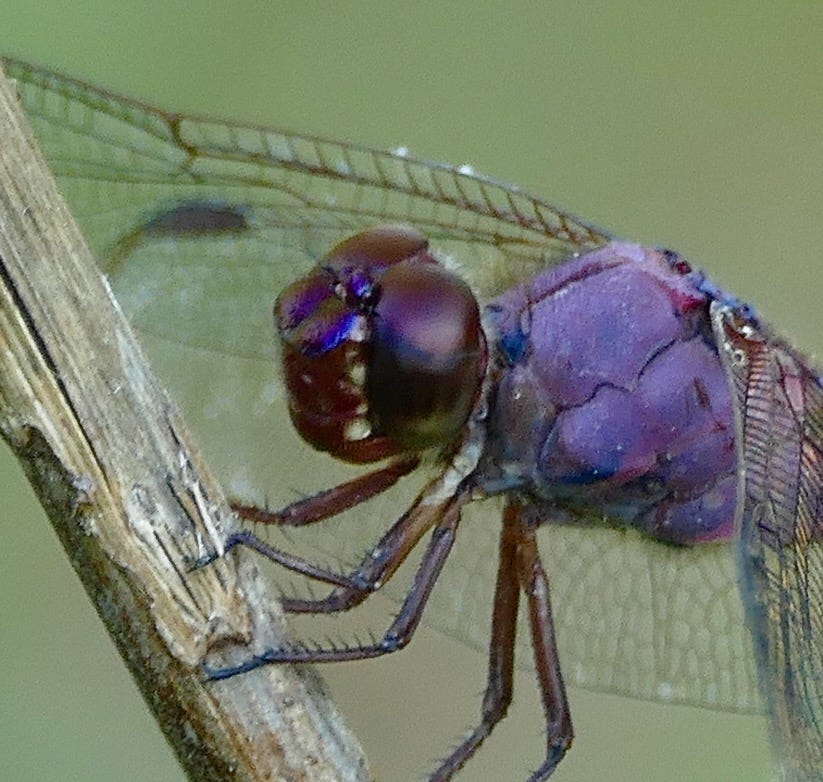
I was thinking about a different bug on Thursday morning as I set out with the dogs: the fly that settled on the Vice President’s head for two long minutes during the debate the night before. Flies are another insect that goes with livestock production. We don’t get many here anymore—maybe the dragonflies are eating them. But we get some, and they always produce that same immediate repulsion. It’s amazing how such an ancient folkloric association of a particular insect with filth, evil and death rot can persist into our hermetically sealed age. It was a primitively powerful image, especially in the wake of the Developer-in-Chief’s surreal Duce balcony unmasking of his contagion face two nights earlier.
That night was World Habitat Day, according to my desk calendar, a United Nations holiday that turns out to be mostly about real estate. Perhaps it was as some counter-observance that the dogs and I went to explore some of our favorite empty lots, which provide a different sort of urban habitat.
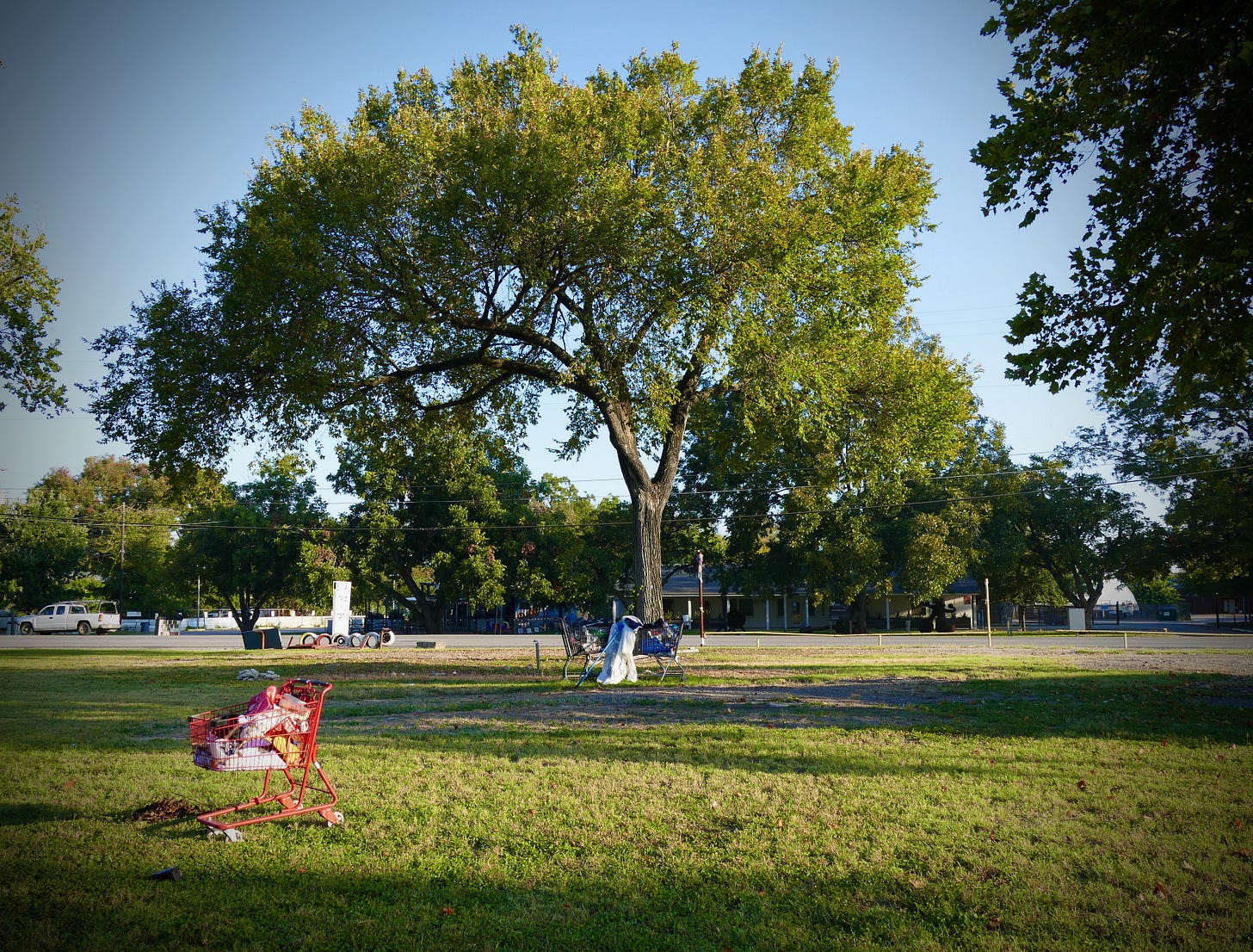
Real estate capital abhors any undeveloped land, and so does its symbiote, municipal government. Urbanists valorize the idea of infill, their code word for the obliteration of vacant lots through new construction to house and office large numbers of people and increase the tax base. It’s an anthropocentric vision of utopia, the notion that every town should strive to express its inner Manhattan. Perhaps it is their endangered status that makes empty lots so beautiful to me. Especially the ones that stubbornly resist their entry on the ledger.
There’s one at the end of our street, an oversized traffic triangle where the old roads to two different river crossings split. It was developed at some point in the past, as you can see from the busted-up concrete pads the grass is growing through. My neighbor Dave says at one time the lot was buried in used tires. But now it is an urban grove of cottonwoods across from a junky prefab warehouse where guys work on old cars. One of those places you often drive by, but rarely enter on foot. When you do, it’s weirdly tranquil, a true island, and those trees that are so much more deeply of this place than anything around them provide a window into what this plain above the river must once have been.
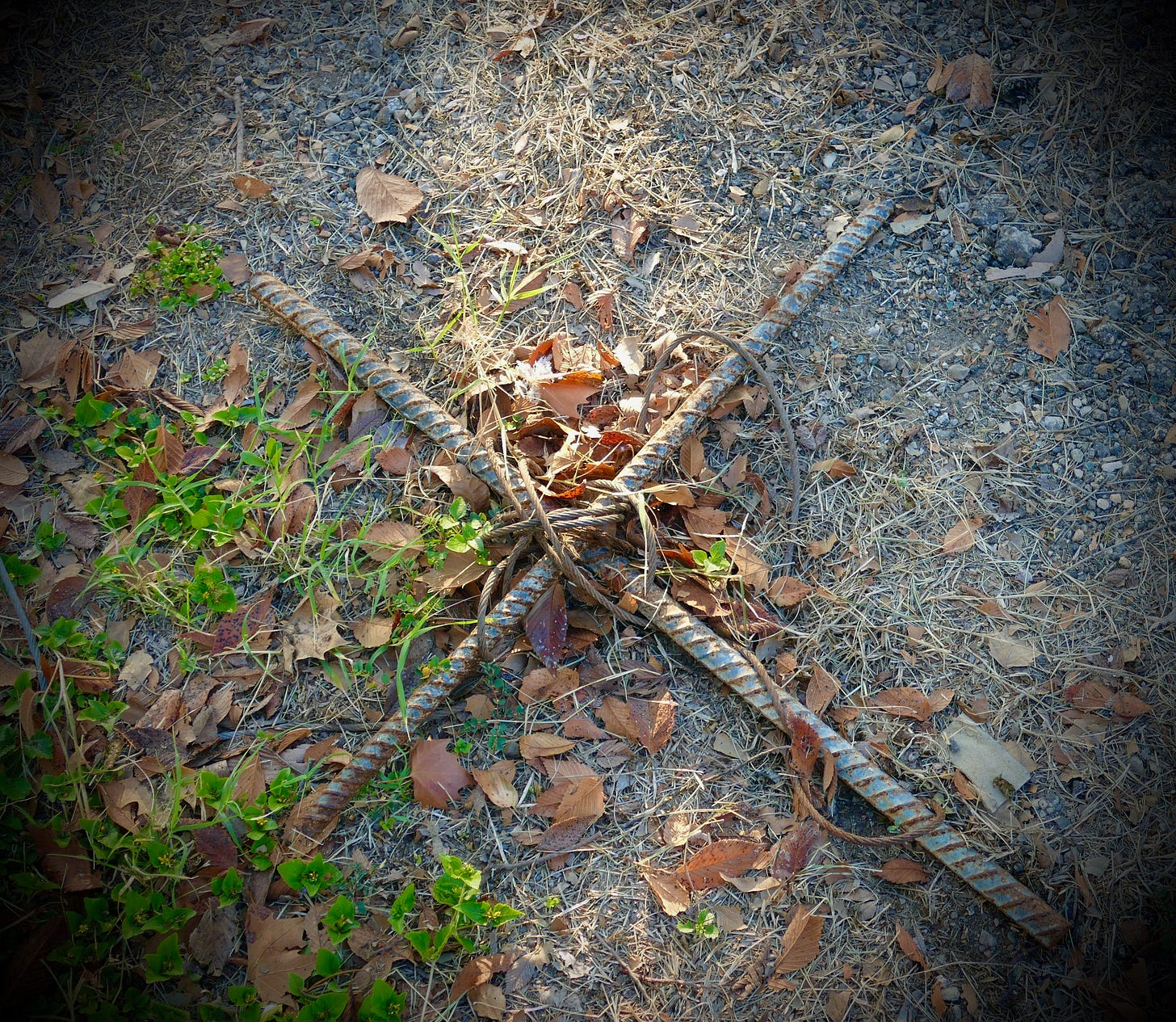
Some local real estate players have been trying to develop a mixed-use project there for several years. They put up a sign with the architects’ rendering of happy young people enjoying urban culinary diversions, wacky shopping opportunities and the wonders of multimodal transportation, but it’s gone now, face down in the dirt, and even the letters spelling out the name and phone number of the realtor on the sign that remains are peeling off and fading out in the Texas sun. Thursday morning the only signs of human life were three overloaded shopping carts left by some of the nomads the developers failed to house, and a crucifix of rebar.
If you walk a couple blocks on from there, past the self-storage facility that has been repurposed as garage band incubator and the headquarters of the charity that delivers meals to the needy and leaves bowls of food out every night for the feral cats, you might find the back entrance to another little urban grove there at the terminus of two dead-end streets. A stand of hackberrys along the line between two empty lots, neither of which are truly empty. On Thursday morning a flock of grackles was in there filling the trees with their neotropical cacophony, a sound that must help those street kittens get their jungle on.
If you bushwhack your way through that tiny wood, you step out into a bigger field anchored by the mast of radio station KNOW, which on Thursday morning was serving as a relay between the rising sun and the waning gibbous moon.

It’s a diminutive antenna by modern standards, somehow blending into the landscape even though you can see it from blocks away. It’s the oldest radio transmission tower in Austin, erected in 1926, radiating 1000 watts of amplitude modulation at 1490 kHz. It was the local ABC affiliate for much of the last century, carrying the news of the Great Depression, World War 2 and the dramas, comedies and ball games of the Golden Age of Radio. In the 60s it went Top 40. Its current owner is a Texas network of solar-powered radio stations, and the tower now emits waves of country music wrapped in vintage static. The audience can’t be much, and the company probably owns and operates it for other business reasons. But it preserves a little square of urban green space at what was, at the time of its construction almost a hundred years ago, beyond the edge of town, and now is prime real estate. In springtime, the field fills with native wildflowers.
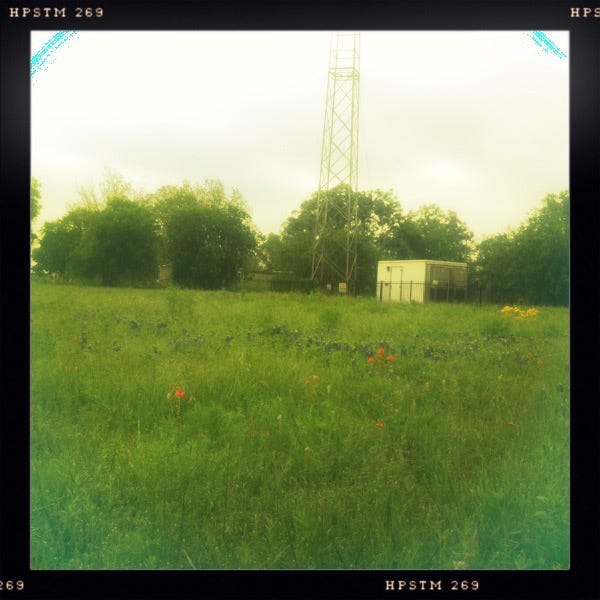
They mow it infrequently, but this week the grass was short, littered with fresh clippings. There aren’t many signs of animal life, but I spotted several big colonies of harvester ants, some of them taking advantage of the already-denuded soil of the desire paths. It got me wondering whether the ants also take advantage of our underground interventions, in a lot full of buried lines. One such line was sticking right up out of the ground, near the base of the antenna but outside the fence that secures the control shed. This line was so old the electrical wires were encased in iron pipe, the colors faded like old candy, maybe connected to burnt-out spark coils.
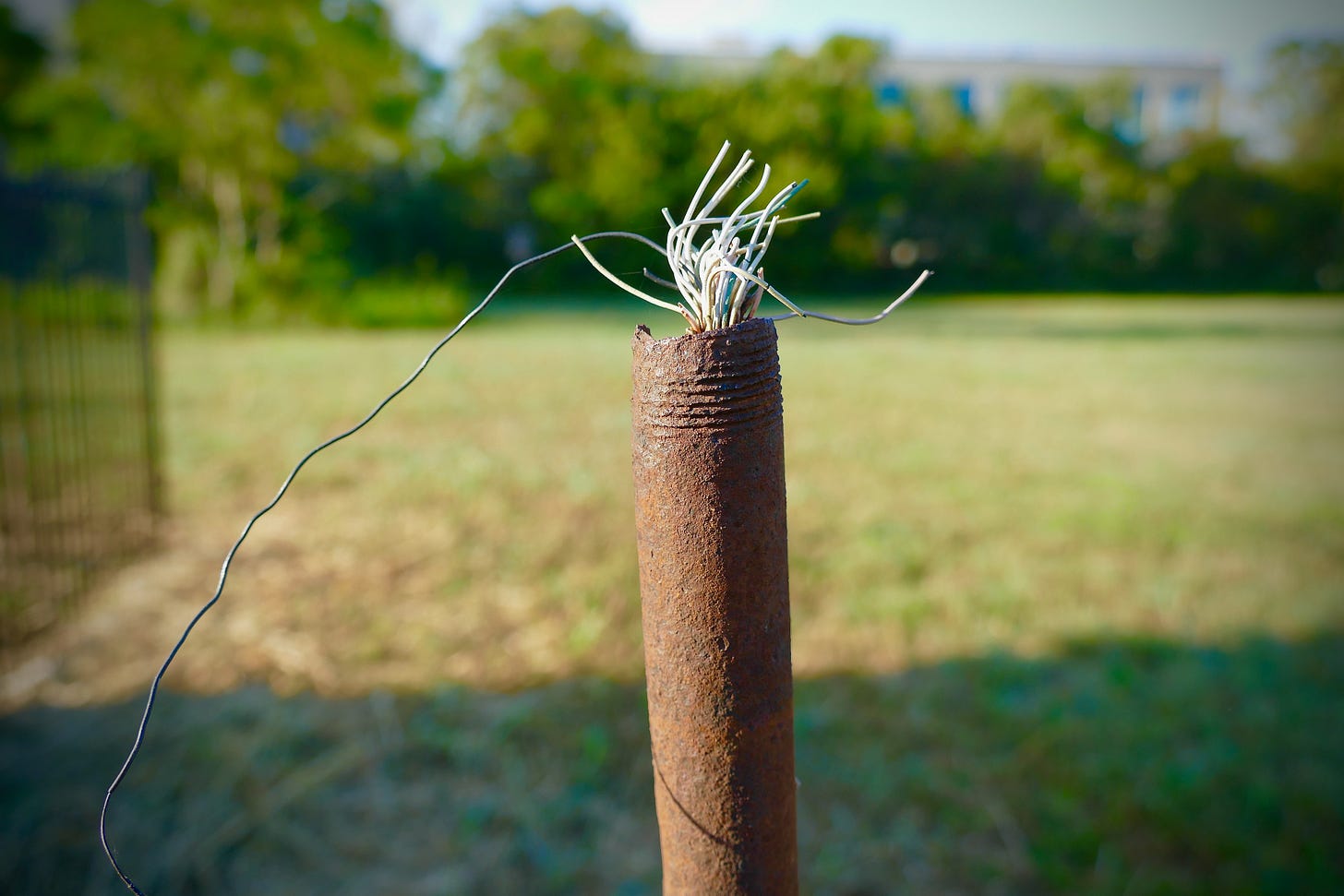
In the background they are building a new office building where the auto salvage yard used to be, and you can see the concrete outlines of the parking garage rising up behind the trees. In its shadows, at the end of a faint path from the street, some dude has made a camp, so hidden you can’t see his shelter from any outside angle, just the three bike trailers and the single orange safety cone that mark the entry to his squatter’s domain.
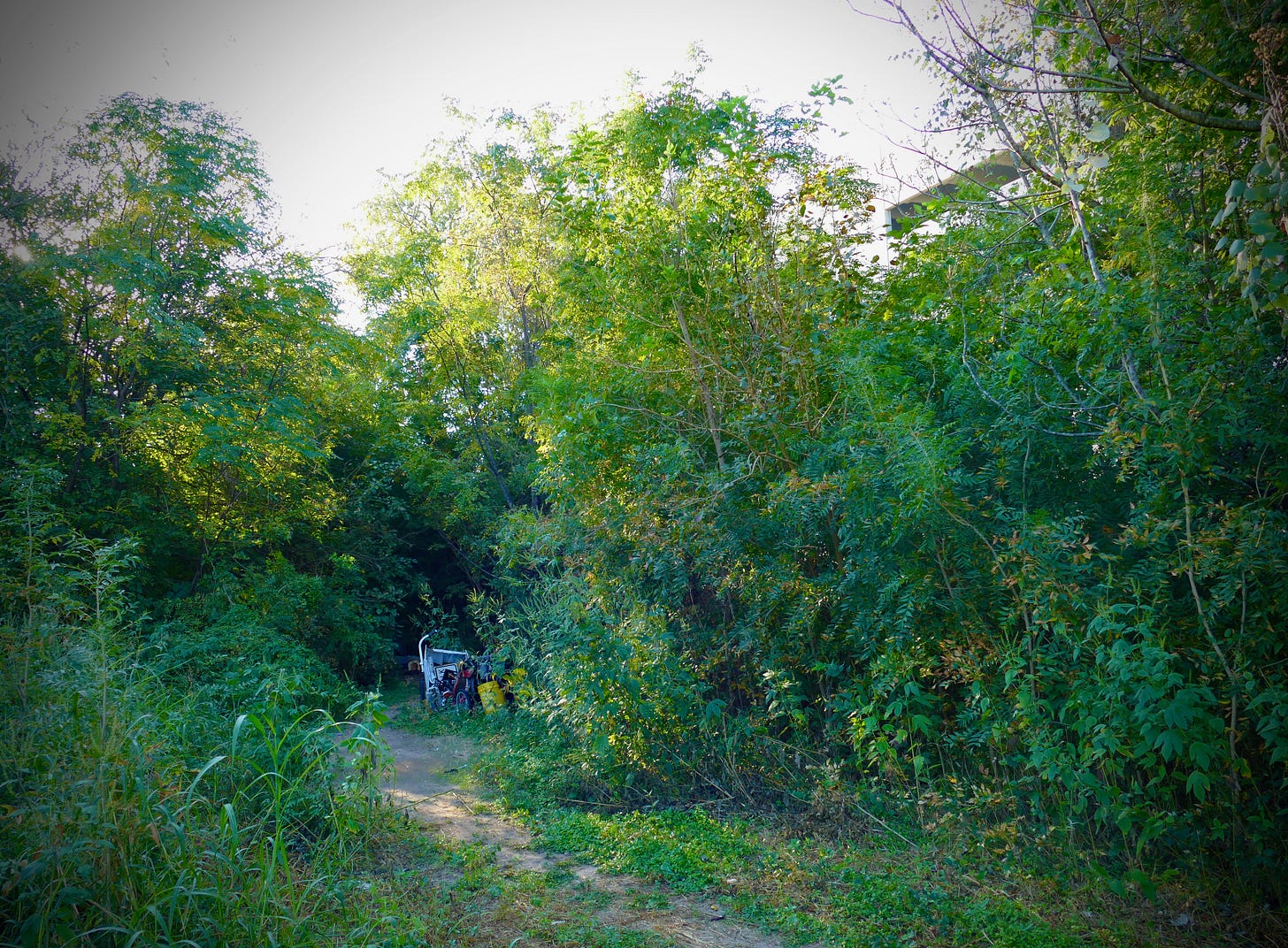
From that spot you can see that he’s sheltered on one side by a large pile of brush that has been pushed back to the margins and left by whoever officially maintains the grounds. A big bloom of old man’s beard was hanging off the slowly disintegrating trunk of some old tree, tiny sunballs of native beauty persisting amid the china berries and patches of Johnson grass popping up in the zone too gnarly to mow.
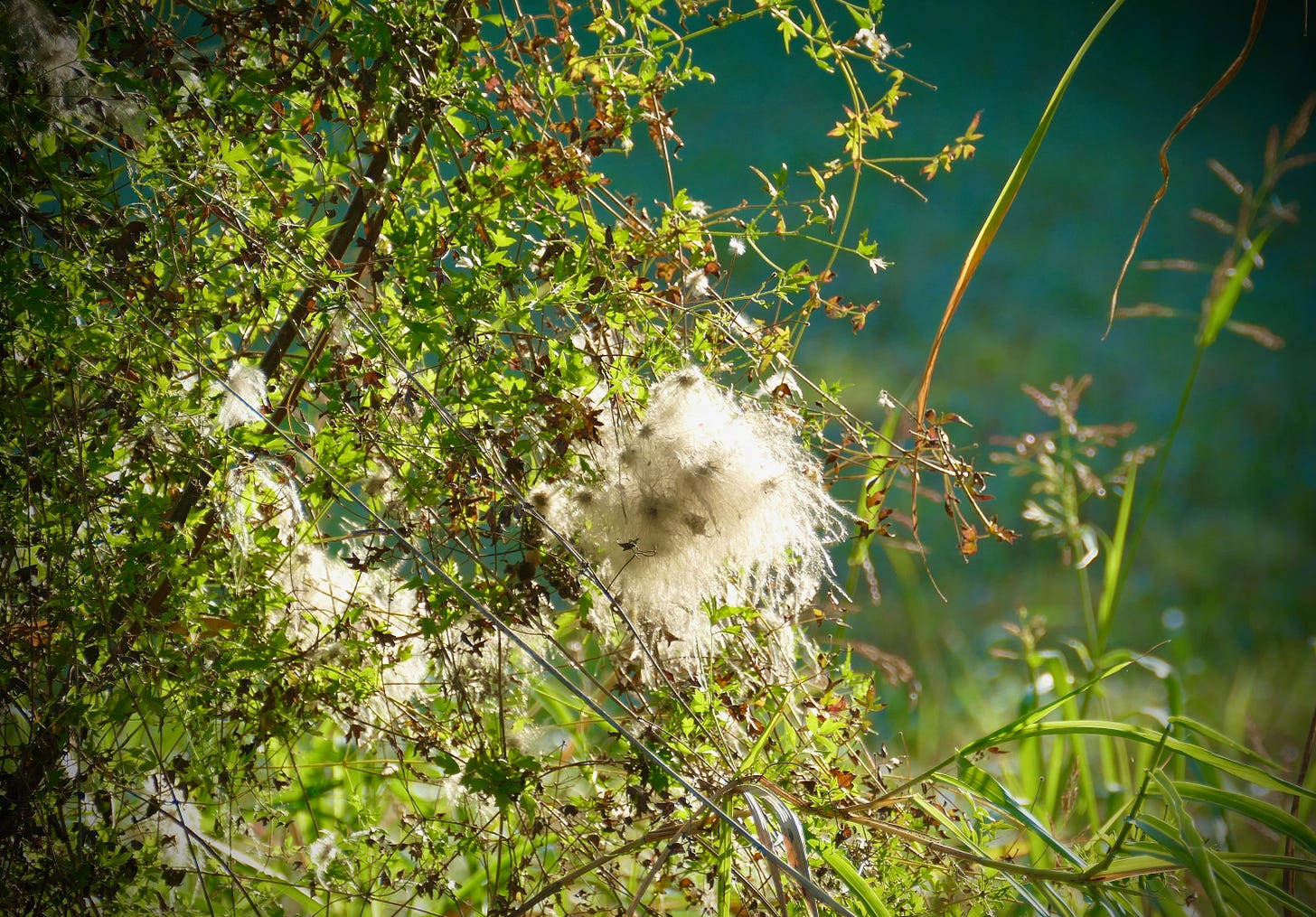
I’ve never seen a raptor or vulture up on that antenna. Maybe the feral cats eat all the songbirds and field mice in addition to the 501(c)(3) kibble the neighbors leave out at night. Maybe the radio waves keep them away, or the country music, or some noise from the installation that’s inaudible to us. Maybe I just haven’t showed up at the right time. One of the first times I walked by, not long after we moved here, it was cold and cloudy, and the eerie romance of the tower grabbed me. I had my headphones on, and the phonebot had shuffled in some melancholy avant-jazz, a track from a new album by a piano trio I liked. When I pulled out my phone to take a picture, I saw the song title:
“The Radio Tower has a Beating Heart.”
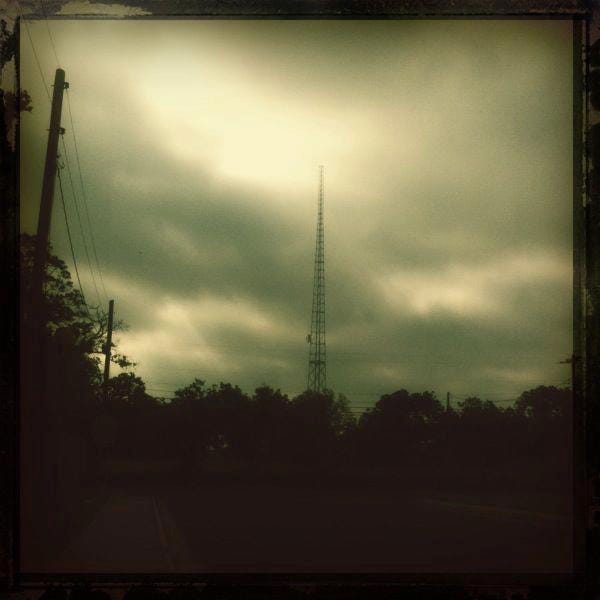
News from the eel net
Hat tip to Field Notes reader, Edwards Aquifer defender and Save Our Springs Alliance Executive Director Bill Bunch for this fascinating Time magazine story about the medievalist who has a developed a cult Twitter following for his use of the platform to deliver a deep cultural history (in 140-character installments) of the relationship between human and eels, from their use as currency to their adoption as an emblem of identity: “Keeping It Eel: How One Historian Is Using Twitter and Medieval Factoids to Help Endangered Animals,” by Olivia B. Waxman, TIME, September 25.
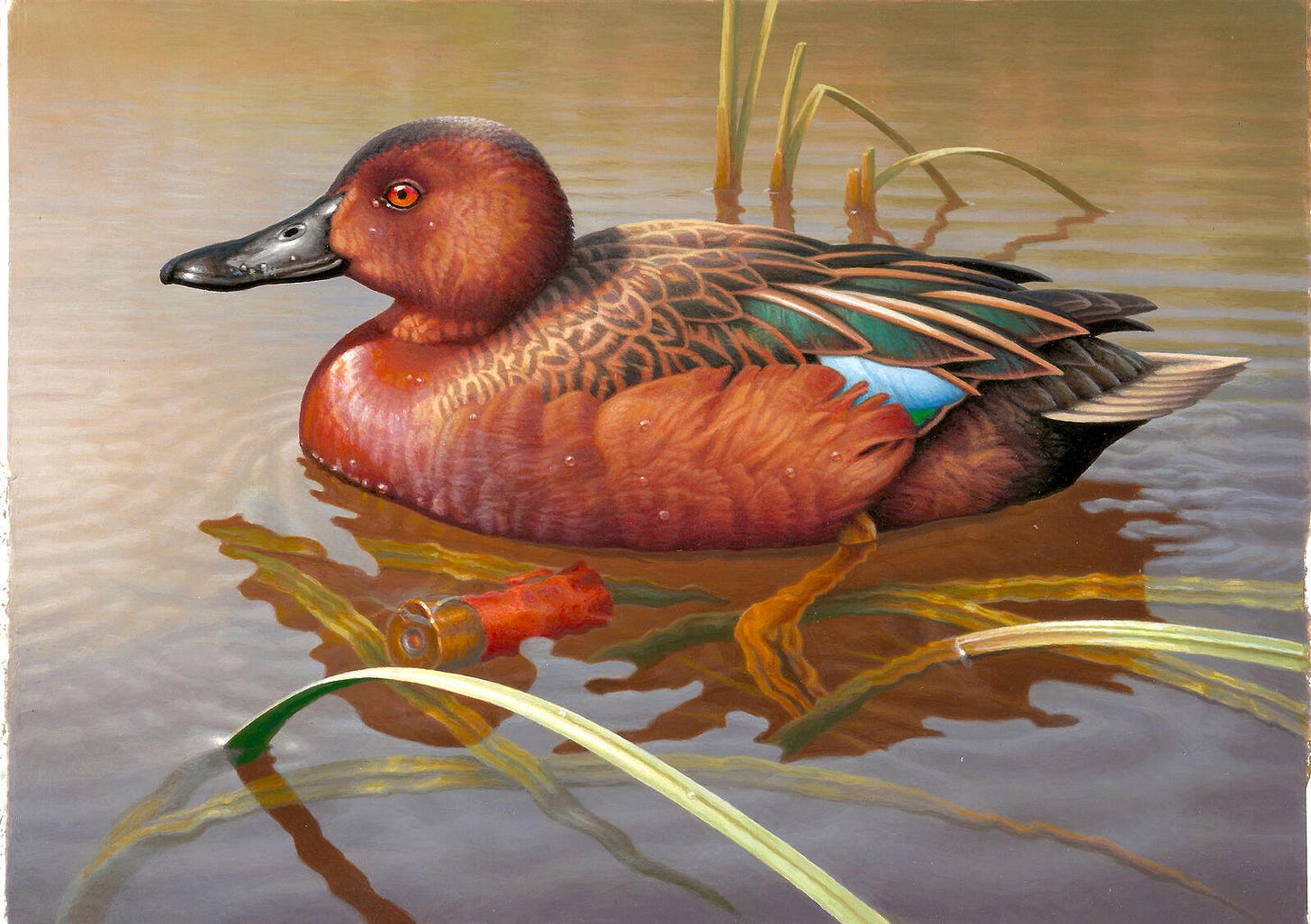
At the nexus of environment, politics and public art, Audubon has a great story on this year's duck stamps issued by the US Fish and Wildlife Service. Duck stamps are not postage, but permits for hunting waterfowl. And while the purpose of the stamps is to fund conservation, the current administration self-parodically amended the duck stamp contest rules to require that all artworks submitted to the contest “must also include appropriate waterfowl hunting-related accessories or elements.” In response, several of the winning artists came up with the idea to integrate the mandatory hunting gear as trash, as with the spent shotgun shell artist Greg Alexander found floating by the Cinnamon Teal pictured above. The ducks on our trashed-out river approve: “Duck Stamp Artists Turn to Spent Shotgun Shells to Meet New Pro-Hunting Mandate,” by Andy McGlashen, Audubon, Oct. 6.
But the most bizarrely ironic bit of news that mixes the natural sciences with current politics was Wednesday night’s report in MIT Technology Review that the President’s recent antibody treatment was developed from human fetal tissue. Last weekend’s feed of Presidential vital signs had me thinking of my friend the writer and physician Michael Blumlein, who died last year, and whose breakthrough 1984 story “Tissue Ablation and Variant Regeneration: A Case Report” is about a physician’s interaction with another president, and if Michael were still around he could have taken this news and run with it: “Trump’s antibody treatment was tested using cells originally derived from an abortion,” by Antonio Regalado, Technology Review, Oct. 7.
In this 2016 recording at Rudy Rucker’s site, Michael reads an early version of his essay “Thoreau’s Microscope,” about the naming of a minor mountain after Henry David Thoreau, the naturalist’s death from tuberculosis, and Michael’s confrontation with his own mortality—including the beauty, from a scientist’s perspective, of his own cancer cells as seen through the microscope. Michael Blumlein, “Unrestrained and Indiscreet.”
On the European front, cybernomadic Austin expat Bruce Sterling this week posted this engaging consideration of the lizards of post-pandemic Ibiza: “Lizards and Islands,” by Bruce Sterling (reviewing a book of that name by Antonia Maria Cicer), at Medium, Oct. 6.
And here’s Twin Cities trio The Bad Plus playing drummer Dave King’s composition, “The Radio Tower Has a Beating Heart,” live at the Dakota in Minneapolis in 2013. The band no longer plays together as a group, rhythm and piano having moved in different artistic directions, but they did amazing work at their peak, charged with a uniquely Midwestern earnest irony.
Lastly, as a sure sign of autumn in Austin, Thursday I came upon my first pecan forager of the season, who looked like he had just walked in out of some old Gilbert Shelton comic. Note the bag hanging from his belt, evidence of a pro.
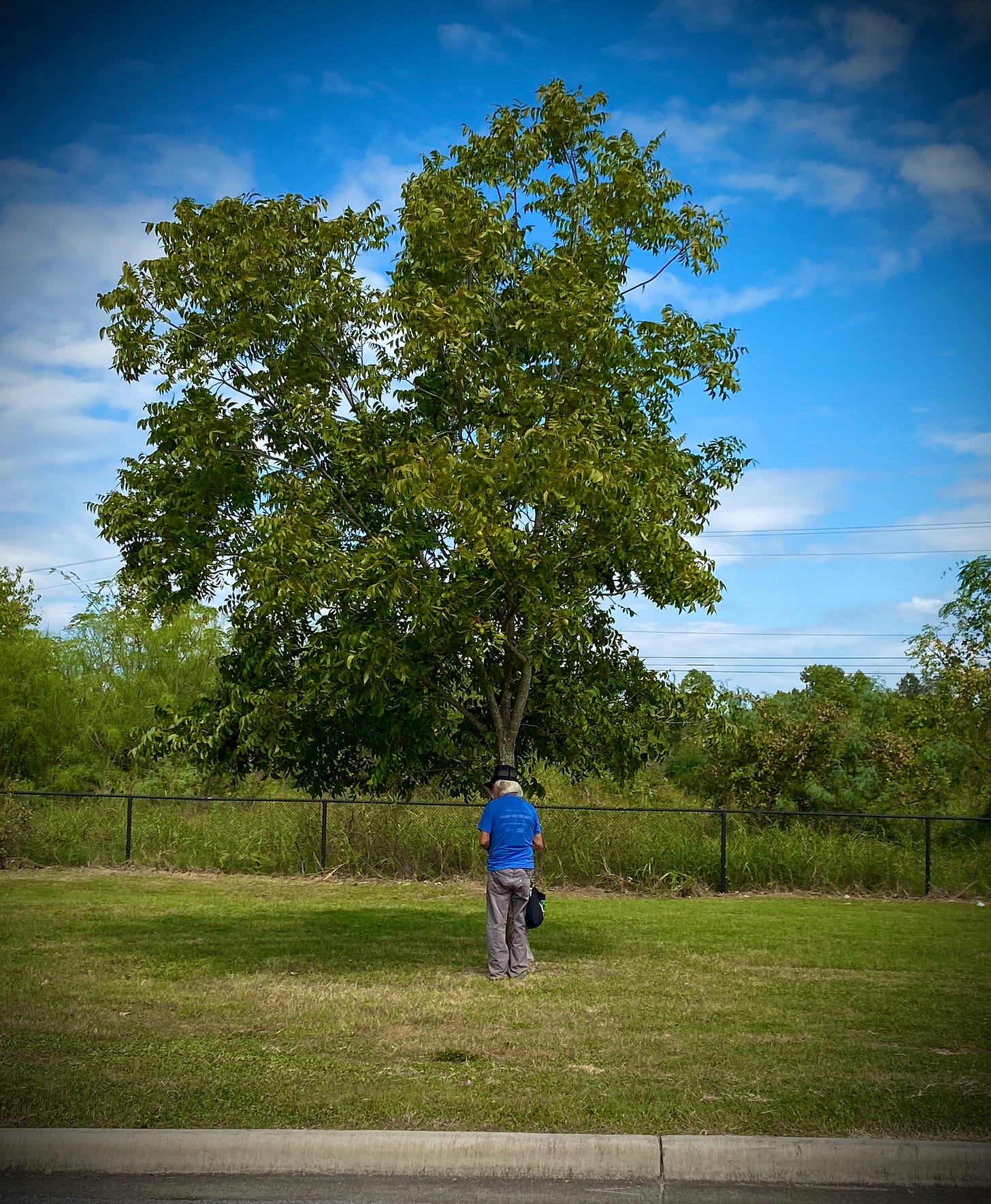
Have a great week, and maybe go do a little foraging yourself.


Well done, “like garnets floating in red wine.” Beautifully written image.